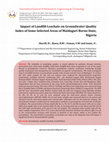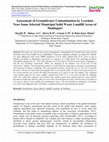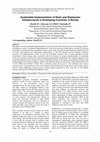Papers by Babagana Sheriff

International Journal of Information, Engineering & Technology, 2021
The reliability of underlying aquifers is mostly affected by pollution through leachate, particul... more The reliability of underlying aquifers is mostly affected by pollution through leachate, particularly from solid waste landfills. Solid waste landfills have been recognized as one of the major threats to groundwater resources. Therefore, groundwater requires continuous monitoring through quality assessments and management for sustainable use against contamination. The study investigates impact of landfill leachate on groundwater quality index of some selected areas of Maiduguri. To achieve the aim; water samples for dry and wet seasons were analysed for physicochemical properties; temperature, turbidity, electrical conductivity (EC) , pH, dissolved oxygen (DO), Biochemical Oxygen Demand (BOD), Chemical Oxygen Demand (COD), Total Dissolved Solids (TDS), Nitrate (NO3), Zinc (Zn), Iron (Fe) , Copper (Cu), Cadmium (Cd), Chromium (Cr), Lead (Pb), Arsenic (As) and Manganese (Mn). Temperature and pH were measured in situ using Turbo pH/mV/temperature meter. Total Dissolved Solid was measured using TDS meter (TDS-3). Turbidity and Electrical Conductivity were measured using Hach Turbidity Meter (2100N) and Hanna Electrical Conductivity Meter (HI98311) respectively. The BOD and DO were determined using Winkler method while the COD was analysed using Refluxing method. Colorimetric method was used to determine Nitrate by Hach Colorimeter (DR/890). The heavy metals (Cu, Zn, Mn, Cd, Pb, As, Cr and Fe) were analysed using the multi-wave plasma atomic emission spectrophotometer, (MP-AES 4200). 5ml of each water samples was measured placed in the system and standard code for each heavy metals were selected after calibration and run the system for analysis. The groundwater analysis revealed that the temperature variations in groundwater were function of climatic conditions. The concentration of heavy metals like Zn, Cu, Pb, Cd, Cr and Mn decreases with rise in water table of an aquifer (dry to wet season) while, Fe and As increases from dry to wet season and this was in line with high concentration of Fe and As in the soil samples. The computed water quality index for the water samples ranged from 10.61-72.4, it was observed that Seasonal variation has advance effect on soil as the concentrations increases with increase in leachate in wet season, which in turn pollute the groundwater. The uncontrolled accumulation of leachate over time at the dumpsites base will impose a significant threat to the groundwater quality.

International Academic Journal of Information, Communication, Technology & Engineering, 2022
The study was carried out to assess groundwater contamination by leachate near some selected muni... more The study was carried out to assess groundwater contamination by leachate near some selected municipal solid waste landfill areas of Maiduguri. Purposive sampling technique was adopted to identify two open Municipal solid waste (MSW) dumpsites A & B which ranged from 18-23 years in age at Kumshe and Bakasi in Maiduguri respectively at a distance of 7.16km apart. Four hand-dug boreholes with depth ranging from 24-32m with a distance of 55.2m and 657.8m between the centre of dumpsite A and the two boreholes respectively. While, for dumpsite B the distance was 25.7m and 317.3m respectively. samples. The groundwater analysis revealed that the temperature variations in groundwater were function of climatic conditions. The concentration of heavy metals like Zn, Cu, Pb, Cd, Cr and Mn decreases with rise in water table of an aquifer (dry to wet season) while, Fe and As increases from dry to wet season and this was in line with high concentration of Fe and As in the soil samples. The computed water quality index for the water samples ranged from 10.61-72.4, it was observed that the sampling wells were within the categories of excellent water quality, good water quality and poor water quality. Seasonal variation has advance effect on soil as the concentrations increases with increase in leachate in wet season, which in turn pollute the groundwater source. The uncontrolled accumulation of leachate over time at the dumpsites base will impose a significant threat to the groundwater quality.

Journal of Emerging Trends in Engineering and Applied Sciences (JETEAS) 10(5):273-281 (ISSN: 2141-7016), 2019
The paper reviewed sustainable implementation of water and wastewater infrastructures in developi... more The paper reviewed sustainable implementation of water and wastewater infrastructures in developing countries. According to sources, sustainable implementation of water and wastewater infrastructure can only be achieved when there is good governance and political interest on the water infrastructural development. Despite the effort of various governments and international organisations to meet the demand gap of adequate freshwater resources, the implementation failed in most of developing countries due to rapid population growth, urbanisation, climate change, poor sustainable skills and strategies for proper implementation of sustainable water and wastewater infrastructure and environmental management. Furthermore, the condition might be worse around sub-Saharan region, because of their fast population growth. In the region, the proportion of people who enjoyed piped water on their buildings, which is the preferred option for urban areas, really reduced from 42% to 34% (WHO and UNICEF, 2014a). This is obviously shows that access to "safe" drinking water sources continues to be a main problem in cities of developing world. Similarly, the trends are the same in good sanitary services. Urban inhabitants without access to better hygiene increased by 40%, from 541 to 754 million, between 1990 and 2012 (WHO and UNICEF, 2014a).

Uploads
Papers by Babagana Sheriff